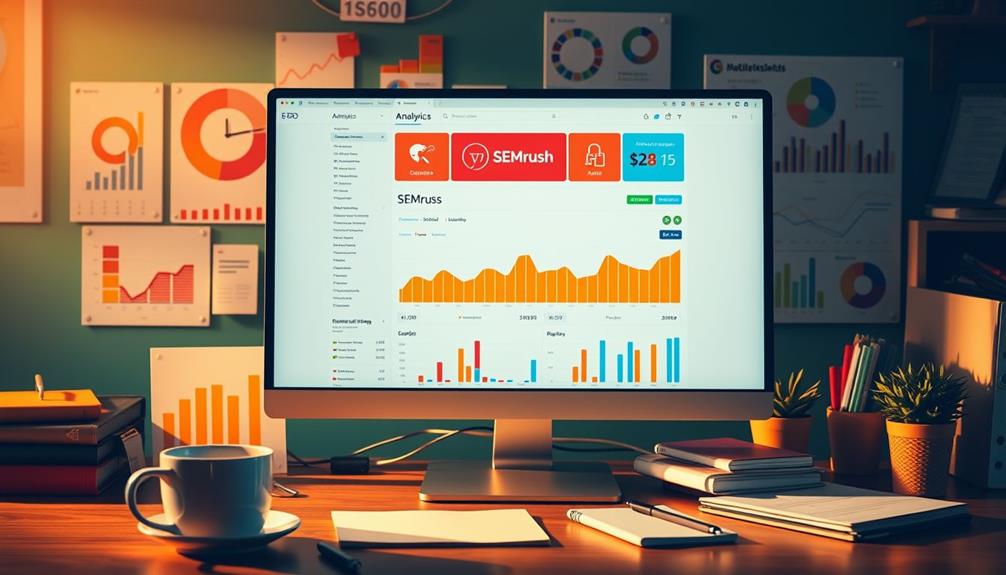Creating an SEO strategy for artisan food makers presents a considerable challenge. Yet, fear not, fellow culinary aficionados, because we’re here to guide you through the intricate world of search engine optimization.
In this article, we will delve into the importance of SEO for artisanal food producers and provide you with practical tips and techniques to boost your online presence.
From identifying target keywords to optimizing website structure, we’ve got you covered. So let’s embark on this SEO journey together and watch your business flourish in the digital realm.
Key Takeaways
- Thorough market research is essential to understand consumer behavior and preferences in the artisanal food market.
- Developing innovative products that meet unmet needs can help artisanal food producers stand out in a competitive market.
- Effective SEO techniques, such as optimizing website content and building high-quality backlinks, can boost online visibility and increase brand awareness.
- Driving organic website traffic through content marketing and implementing SEO strategies is crucial for attracting more visitors and potential customers.
Understanding the Artisanal Food Market
Understanding the artisanal food market requires researching current trends and analyzing consumer preferences. As artisanal food producers, it’s crucial for us to stay ahead of the game and develop unique product offerings that cater to the desires of our target audience. By understanding consumer preferences, we can tailor our products to meet their specific needs and stand out in a competitive market.

To gain a deep understanding of consumer preferences, we must conduct thorough market research. This involves analyzing data on consumer behavior, preferences, and purchasing patterns. By studying trends and gathering insights, we can identify gaps in the market and develop innovative products that meet unmet needs. This research also allows us to stay on top of evolving consumer preferences, ensuring our offerings remain relevant and appealing.
Another key aspect of understanding consumer preferences is engaging with our target audience directly. By actively listening to their feedback and interacting with them through surveys, social media, and other channels, we can gain valuable insights into their likes, dislikes, and desires. This direct engagement helps us build a strong relationship with our customers and ensures that our product offerings align with their preferences.
Importance of SEO for Artisanal Food Producers
When it comes to artisanal food producers, implementing a strong SEO strategy is crucial for success in the digital landscape. By boosting online visibility through effective SEO techniques, such as optimizing website content and building high-quality backlinks, producers can reach a wider audience and increase brand awareness.
Additionally, SEO helps drive organic website traffic, leading to more potential customers discovering and engaging with their products.

Boosting Online Visibility
By optimizing our online presence through strategic SEO techniques, we can effectively boost visibility for artisanal food producers. In today’s digital age, having a strong online presence is crucial for enhancing brand image and reaching a wider audience.
One effective way to boost online visibility is by utilizing influencer marketing. Collaborating with influencers who have a strong following in the food industry can help increase brand exposure and credibility. These influencers can promote our products through their social media platforms and blogs, reaching a larger audience of potential customers.
Additionally, optimizing our website with relevant keywords, meta tags, and high-quality content can improve our search engine rankings, making it easier for customers to find us online.
Driving Organic Website Traffic
To further enhance our online visibility and reach a wider audience, we can drive organic website traffic through effective SEO strategies. By increasing brand awareness and implementing content marketing, we can attract more visitors to our website and ultimately increase sales. SEO is crucial for artisanal food producers as it allows us to optimize our website and content to rank higher in search engine results. This means that when potential customers search for keywords related to our products, our website will appear at the top, driving more organic traffic.

To illustrate the importance of SEO for driving organic website traffic, consider the following table:
| SEO Strategy | Benefits | Examples |
|---|---|---|
| Keyword optimization | Higher search engine rankings | Including relevant keywords in page titles and meta descriptions |
| Content creation | Increased website engagement | Publishing blog posts and recipes related to our artisanal food products |
| Link building | Enhanced credibility | Earning backlinks from reputable food blogs and websites |
| Local SEO optimization | Targeted local audience | Including location-specific keywords in our content and meta tags |
As we can see, implementing effective SEO strategies can greatly impact our website traffic and overall online presence. Moving forward, let’s now explore the process of identifying target keywords and phrases to further optimize our website.
Identifying Target Keywords and Phrases
As artisanal food producers, we must identify the target keywords and phrases that will greatly enhance our SEO strategy. One effective approach is to focus on long tail keywords for artisanal food producers. These are specific and highly relevant keyword phrases that are more likely to attract our target audience and result in higher conversion rates.
For example, instead of targeting the generic keyword ‘artisanal cheese,’ we can target long tail keywords like ‘organic artisanal cheese made in small batches’ or ‘award-winning artisanal cheese from local farms.’ By incorporating these long tail keywords into our website content, blog posts, and product descriptions, we can better optimize our website for search engines and increase our visibility to potential customers.

Another crucial aspect of identifying target keywords and phrases is optimizing product descriptions for SEO. When crafting product descriptions, we shouldn’t only focus on providing enticing and informative content for our customers but also include relevant keywords. By incorporating keywords related to our products, such as specific ingredients, flavors, or unique selling points, we can improve the visibility of our products in search engine results.
Additionally, we should ensure that our product descriptions are concise, accurate, and easy to read, as this will help both search engines and customers find and understand our products.
Conducting Competitor Analysis
When it comes to conducting competitor analysis, we need to start by identifying our key competitors in the artisanal food industry.
Once we’ve identified them, we can analyze their strategies to understand what they’re doing well and where they may have weaknesses.

Identifying Key Competitors
We analyze our competitors to identify key players in the artisanal food industry and gain insights for crafting our SEO strategy. By employing competitive analysis techniques, we can understand the strengths and weaknesses of our rivals, allowing us to capitalize on their vulnerabilities and stand out in the market.
This process involves identifying market gaps, which are areas where our competitors may be lacking or not fully addressing customer needs. Through this analysis, we can determine how we can differentiate ourselves and fill these gaps, giving us a competitive edge.
Analyzing Competitor Strategies
To better understand our rivals and gain a competitive edge in the artisanal food industry, we analyze the strategies employed by our key competitors through conducting a thorough competitor analysis.
One important aspect of this analysis is evaluating competitor backlink profiles. By examining the backlinks that point to our competitors’ websites, we can gain insights into their link-building strategies and identify potential opportunities for our own backlink acquisition.

Additionally, we analyze competitor keyword rankings to understand which keywords they’re targeting and how they’re performing in search engine rankings. This information helps us identify gaps in our own keyword strategy and optimize our website content accordingly.
Leveraging Competitor Weaknesses
By analyzing our competitors’ strategies and identifying their weaknesses, we can effectively leverage their vulnerabilities to gain a competitive advantage in the artisanal food industry. Conducting a competitive analysis allows us to understand the landscape and identify areas where our competitors are lacking.
Here are three ways we can exploit competitor weaknesses:
- Differentiate our product: By understanding what our competitors are offering and where they fall short, we can position our artisanal food products as unique and superior in those areas. This allows us to stand out and attract customers who are looking for something different.
- Improve our marketing strategy: Analyzing our competitors’ marketing efforts can help us identify gaps in their strategies. We can then develop targeted campaigns that highlight our strengths and address the weaknesses of our competitors, effectively stealing their customers.
- Enhance customer experience: By studying our competitors’ customer service practices, we can identify areas where they’re lacking and improve our own customer experience. This can include offering better support, faster delivery, or more personalized interactions.
Optimizing Website Structure and Navigation
When optimizing the structure and navigation of our website for artisanal food producers, it’s important to strategically organize and streamline the content to enhance user experience and improve search engine rankings. A well-designed website not only attracts visitors but also keeps them engaged, leading to higher conversion rates. To achieve this, we must focus on website design and user experience.

An effective website design begins with a clear and intuitive navigation menu that allows users to easily find the information they need. We should organize our content into logical categories and subcategories, using descriptive labels that accurately represent the content within. Additionally, incorporating internal links throughout the website can help users navigate between pages and discover related content, thereby increasing their time on site.
Streamlining the website structure enables search engine crawlers to navigate and index our pages more efficiently, resulting in better visibility on search engine result pages. By optimizing our URLs, meta tags, and header tags, we can provide search engines with relevant information about our website and its content, further improving our rankings.
Creating High-Quality and Relevant Content
When it comes to creating high-quality and relevant content for artisanal food producers, there are two key points to consider.
First, engaging food-related storytelling can help captivate your audience and build a strong brand identity. By sharing the story behind your products and highlighting the unique aspects of your craft, you can create a connection with your customers.

Second, optimizing your content for search engines is crucial for driving organic traffic to your website. This involves conducting keyword research and strategically incorporating relevant keywords into your content to improve its visibility in search results.
Engaging Food-Related Storytelling
As artisanal food producers, we create high-quality and relevant content by engaging in food-related storytelling. Storytelling techniques for engaging food related content are essential in capturing the attention and emotions of our audience. Here are three powerful storytelling techniques we employ:
- Personal Narratives: We share our personal stories behind the creation of our artisanal products, connecting with our audience on a deeper level and emphasizing our passion and dedication.
- Visual Storytelling: We leverage the power of visual storytelling in the artisanal food industry, using captivating images and videos to showcase the beauty and craftsmanship of our products, enticing our audience’s senses.
- Origin Stories: We highlight the origins of our ingredients, taking our audience on a journey to the farms, vineyards, or orchards where our ingredients are sourced, emphasizing the authenticity and sustainability of our products.
By incorporating these storytelling techniques, we create content that resonates with our audience and establishes a strong brand identity.
Now, let’s explore how we can optimize this content for search engines.

Optimizing for Search Engines
To optimize our content for search engines, we focus on creating high-quality and relevant content that resonates with our audience. By implementing effective SEO techniques and conducting thorough keyword research, we ensure that our content ranks well in search engine results and reaches our target customers.
One important aspect of optimizing for search engines is understanding the keywords that our audience is using when searching for artisanal food products. This allows us to incorporate those keywords strategically into our content, making it more likely to appear in relevant search results. Additionally, we ensure that our content is informative, concise, and keyword-focused, providing valuable information to our audience while also meeting search engine requirements.
In order to engage our audience and provide them with a comprehensive understanding of our artisanal food products, we have created the following table:
| SEO Technique | Description |
|---|---|
| Keyword Research | Conducting thorough research to identify relevant keywords for our content. |
| On-Page Optimization | Optimizing our website pages with relevant keywords, meta tags, and headers. |
| Quality Content | Creating high-quality and engaging content that provides value to our audience. |
| Link Building | Building a network of high-quality backlinks to increase our website’s authority. |
| Mobile Optimization | Ensuring that our website is optimized for mobile devices to improve user experience. |
Utilizing Local SEO Strategies
In order to enhance online visibility and attract local customers, we can effectively utilize local SEO strategies. By implementing these strategies, artisanal food producers can increase their chances of being found by potential customers in their local area. Here are three key ways to utilize local SEO strategies:

- List your business in local business directories: This is a great way to improve your online visibility and ensure that your business information is accurate and up-to-date. By listing your business in directories such as Google My Business, Yelp, and TripAdvisor, you can increase your chances of appearing in local search results.
- Optimize your website for local keywords: Conduct keyword research to identify the terms that local customers are using to search for artisanal food products. Incorporate these keywords into your website’s meta tags, headings, and content to improve your chances of ranking higher in local search results.
- Create localized content: Develop blog posts, articles, and other content that’s specifically targeted towards your local audience. This can include highlighting local ingredients, featuring local events or partnerships, and showcasing local customer testimonials. By creating content that resonates with your local customers, you can build trust and establish yourself as a go-to source for artisanal food products in your area.
Building a Strong Social Media Presence
We frequently engage with our audience on social media platforms to build a strong online presence and connect with potential customers. Building a strong social media presence is essential for artisanal food producers looking to increase brand awareness and reach a wider audience.
One effective strategy is to form influencer partnerships, where popular social media personalities promote our products to their followers. By collaborating with influencers who align with our brand values and target market, we can tap into their existing audience and gain exposure to potential customers who may be interested in our artisanal food offerings.
Additionally, user generated content plays a crucial role in building a strong social media presence. Encouraging customers to share their experiences with our products through reviews, photos, and videos not only increases engagement but also serves as authentic testimonials for potential customers. It’s important to actively monitor and engage with user generated content, showing appreciation and responding to comments and reviews.
By implementing influencer partnerships and leveraging user generated content, we can establish a robust social media presence that fosters brand loyalty and attracts new customers.

Now, let’s explore how implementing effective on-page SEO techniques can further enhance our online visibility and drive organic traffic to our website.
Implementing Effective On-Page SEO Techniques
As we delve into implementing effective on-page SEO techniques, it’s crucial for artisanal food producers to optimize their website’s content and structure to improve online visibility and attract organic traffic. Here are three key strategies that can help achieve this:
- Keyword research: Conduct thorough research to identify relevant keywords that your target audience is using to search for artisanal food products. Incorporate these keywords strategically into your website’s content, including headings, product descriptions, and blog posts. This won’t only improve your website’s ranking on search engine results pages but also ensure that your content aligns with what your potential customers are looking for.
- Optimizing meta tags: Meta tags are HTML elements that provide information about a webpage to search engines. By optimizing meta tags such as title tags and meta descriptions with relevant keywords, you can help search engines understand the content of your pages better. This can lead to higher rankings and increased click-through rates from search engine users.
- Structured data markup: Incorporating structured data markup, such as schema markup, into your website’s HTML code can provide additional context to search engines. This can help improve the visibility of your website in search results by displaying rich snippets, such as star ratings or cooking times, which can make your listing stand out and attract more clicks.
By implementing these on-page SEO techniques, artisanal food producers can enhance their website’s visibility, attract more organic traffic, and ultimately increase their chances of converting visitors into customers.
Now, let’s transition into the next section where we’ll discuss the importance of generating backlinks from authority websites.

Generating Backlinks From Authority Websites
To improve the website’s search engine optimization, artisanal food producers can generate backlinks from authority websites by partnering with established industry leaders. Link building strategies and outreach tactics play a vital role in this process.
One effective way to generate backlinks is by reaching out to authority websites in the food industry and proposing a collaboration. By partnering with these industry leaders, artisanal food producers can gain exposure to a wider audience and establish their credibility. This can be done through guest posting, where the producer writes an informative article for the authority website and includes a backlink to their own website. This not only drives traffic to the producer’s website but also improves their search engine ranking.
Another strategy is to collaborate on content creation. By co-creating valuable and relevant content with authority websites, artisans can build a mutually beneficial relationship. This could include creating a joint blog post, hosting a webinar together, or even collaborating on a recipe book. These collaborations not only increase the chances of obtaining backlinks but also enhance the producer’s reputation in the industry.
Monitoring and Analyzing SEO Performance
In order to effectively monitor and analyze the performance of our SEO strategy, we need to utilize various tools and metrics. Tracking progress and measuring success are essential to ensuring that our efforts are yielding the desired results.

Here are three key steps to help us monitor and analyze our SEO performance:
- Set clear goals and objectives: Before we can measure the success of our SEO strategy, we need to establish specific goals and objectives. This will allow us to track our progress and determine if we’re moving in the right direction. Whether it’s increasing organic traffic, improving search engine rankings, or driving more conversions, having clear goals will provide us with a benchmark for success.
- Use analytics tools: Utilizing analytics tools such as Google Analytics can provide valuable insights into our SEO performance. These tools can help us track important metrics like organic traffic, bounce rate, conversion rate, and keyword rankings. By regularly monitoring these metrics, we can identify areas of improvement and make data-driven decisions to optimize our SEO strategy.
- Conduct regular audits: Regularly auditing our website’s SEO performance is crucial in identifying any issues or opportunities for improvement. This involves analyzing factors like website speed, mobile-friendliness, and website structure. By conducting regular audits, we can ensure that our website is optimized for search engines and provide a seamless user experience.
Leveraging Online Reviews and Testimonials
We can maximize the impact of our SEO strategy by harnessing the power of online reviews and testimonials. Leveraging customer feedback is a crucial aspect of building trust and credibility for artisanal food producers.
Positive reviews and testimonials not only help to attract new customers but also improve search engine rankings. When customers leave positive reviews about our products, it signals to search engines that our website is trustworthy and relevant. This can lead to higher organic search rankings, increasing our visibility to potential customers.
To effectively leverage customer feedback, we should actively encourage our satisfied customers to leave reviews and testimonials on popular review platforms such as Google My Business, Yelp, and TripAdvisor. Additionally, we can embed customer testimonials on our website to showcase the positive experiences of our customers. This not only provides social proof but also enhances the overall user experience.

In addition to customer feedback, partnering with influencers in the food industry can significantly impact our SEO strategy. Collaborating with influencers who’ve a strong online presence and a dedicated following can help us reach a wider audience and gain exposure. By featuring our products in their content or endorsing our brand, influencers can generate positive reviews and testimonials that can boost our SEO efforts.
Staying Updated With SEO Trends and Best Practices
To effectively stay updated with SEO trends and best practices, we actively research and implement strategies that align with our goals as artisanal food producers. Staying ahead of the competition requires us to understand the latest developments in the SEO landscape and adapt our website accordingly.
Here are three key areas we focus on to ensure our online presence remains optimized:
- Understanding voice search optimization: Voice search is rapidly growing in popularity, with more and more people using devices like smart speakers and virtual assistants to search for information. We optimize our website by incorporating natural language keywords and phrases that align with how people speak. By understanding how voice search works and tailoring our content to match user intent, we increase our chances of ranking higher in voice search results.
- Implementing mobile-friendly design: With the majority of internet users accessing websites through mobile devices, having a mobile-friendly website is crucial for SEO success. We ensure that our website is responsive and loads quickly on mobile devices. This includes optimizing images, using mobile-friendly fonts, and simplifying navigation for a seamless user experience. By prioritizing mobile optimization, we improve our chances of ranking higher in mobile search results.
- Staying updated with algorithm changes: Search engines constantly update their algorithms, and it’s essential for us to stay informed about these changes. We actively monitor industry news and reputable SEO resources to ensure that our SEO strategies align with the latest best practices. By staying updated, we can adapt our SEO efforts accordingly and maintain our visibility in search engine results.
Conclusion
Crafting an effective SEO strategy for artisanal food producers is essential to ensure their online presence and visibility. By identifying target keywords, conducting competitor analysis, and optimizing website structure, producers can enhance their online visibility and attract more customers.

Generating backlinks and monitoring performance are also important aspects of an effective SEO strategy. Backlinks from reputable websites can improve search engine rankings, while monitoring performance allows producers to track the success of their SEO efforts and make necessary adjustments.
In addition, leveraging online reviews can be a powerful tool for increasing visibility and attracting new customers. Positive reviews can help build trust and credibility, while responding to negative reviews shows a commitment to customer satisfaction.
Lastly, staying updated with SEO trends is crucial for success in the fast-paced world of online marketing. SEO algorithms and best practices are constantly evolving, so producers must stay informed and adapt their strategies accordingly.
In conclusion, by implementing these strategies and staying ahead of the game, artisanal food producers can let their products shine brightly in the digital landscape.











